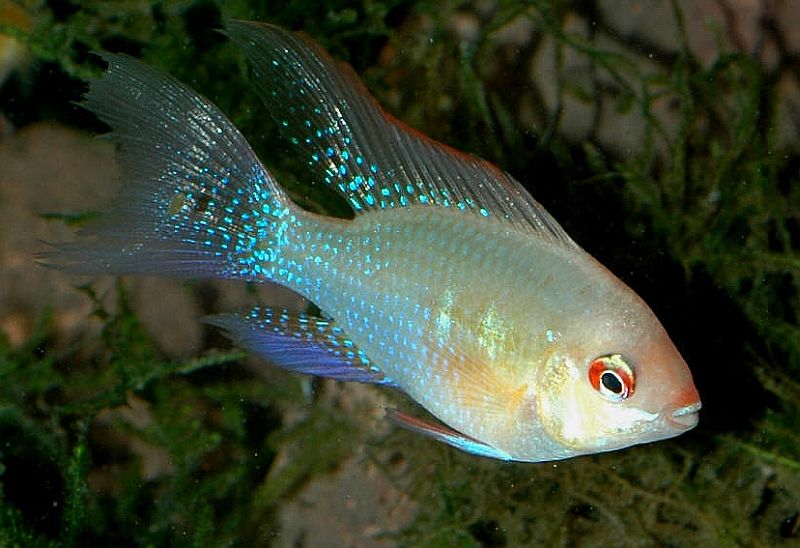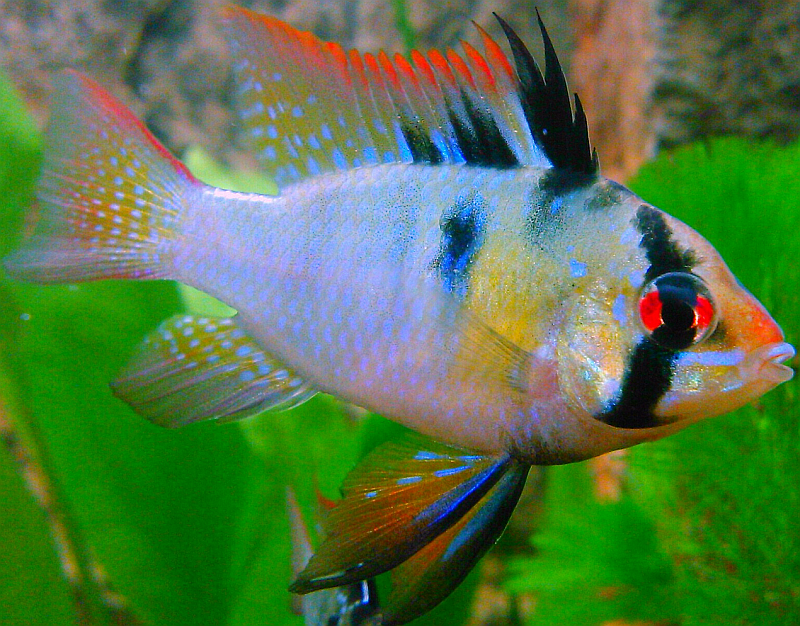Ram Cichlids (Mikrogeophagus ramirezi) are a peaceful, social species of Dwarf cichlid that are found in the Orinoco River basin in Venezuela and Columbia, South America.
There are several color variations of Mikrogeophagus ramirezi that lend to their common names such as German Blue Ram, Electric Blue Ram, German Gold Ram, Butterfly Cichlid, Blue Ram, Gold Ram, Golden Ram, Gold German Ram, Blue German Ram, and Singapore Ram.
Although their official scientific name is Mikrogeophagus ramirezi; Ram Cichlids are also called Microgeophagus ramirezi, Apistogramma ramerizi, or Papiliochromis ramirezi which can often cause additional confusion to tropical fish keeping enthusiasts.
Regardless of what you call them, Ram Cichlids are prized by tropical fish keeping enthusiasts for their beautiful colors, peaceful dispositions, and interesting personalities.
The Ram’s description is obviously based on color variations, but wild caught specimens and males in particular, are always more colorful than females.
German Blue Ram are known for their mottled deep blue splotches of color. German Gold Rams have gold colored bodies with pink, red, and orange hues, and Electric Blue Rams are colored a dramatic electric blue over their entire body.
Although they have an extremely peaceful nature, their black spiked dorsal fin and low slung pectoral fins give them a ferocious look.
The Longfin German Blue Ram pictured to the left, has beautiful iridescent blue flecks over the body, with a tinge of gold toward the head.
Both sexes posses the spiked dorsal fin, which in males is noticeably more pronounced. The black spot in the middle of the body in males lacks the blue coloration that the females posses.
Females are slightly smaller than males and have pinkish colored undersides.
Although Ram Cichlids are not a true “shoaling” species, they do well in small groups. Ram Cichlids are slow swimmers and can become easily stressed. They require a densely planted aquarium of at least 20 gallon capacity where they can easily hide, a sandy or fine gravel substrate, a couple of rock caves, some driftwood, and plenty of free swimming space.
They can be housed with other peaceful species of approximately the same size but are sensitive to water conditions and need a spotlessly clean environment to thrive. Regular water changes are essential for this species.
Once they are sexually mature, Ram Cichlids are relatively easy to breed. Rams breed best in soft to medium hard water with a neutral pH and a water temperature between 77° and 82°F. Some peat or Indian Almond Leaves should be added to the water if desired to maintain the pH and prevent fungal problems.
Ram Cichlids are monogamous and will faithfully pair with just one mate for life. Like many cichlids, both sexes share the brooding and defense of their young, and males will not tolerate other males in the vacinity of their territory.
When close to spawning, the female ram will develop a pink or red blush on their abdomen. Females will lay between 100 to 500 tiny (.9 to 1.5 mm) adhesive eggs on a flat stone or in small depressions fanned out in the sandy bottom. They “fan” the water over their eggs which will normally hatch out in approximately 40 hours at a temperature of 85 degrees F.
Within five days the fry will absorb their egg sacs and become free swimming. During this time the pair will escort the fry around the tank to forage for food. When the egg sacs are absorbed, they can be fed newly hatched baby brine shrimp, daphnia, or finely crushed flake food.
Ram Cichlids are easy to feed in an aquarium environment. They will eagerly accept micro cichlid pellets and a quality flake food with occasional treats of fresh, frozen, or freeze dried tubifex, brine shrimp, bloodworms, etc.
Except for some varieties, most Ram cichlids are readily available to tropical fish keeping enthusiasts when they are between 1″ to 1-1/2″ in size.
Minimum Tank Size: 20 gallons
Care Level: Difficult
Temperament: Peaceful
Aquarium Hardiness: Hardy
Water Conditions: 72-79° F, KH 5-12, pH 5.0-7.0
Max. Size: 3”
Color Form: Blue, Orange, Red, Yellow
Diet: Omnivore
Compatibility: OK with small peaceful species
Origin: Venezuela, Columbia
Family: Cichlidae
Lifespan: 3-5 years
Aquarist Experience Level: Intermediate




